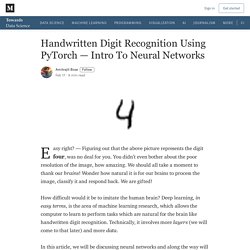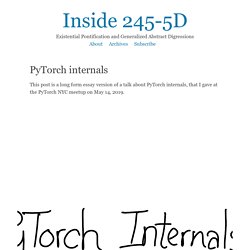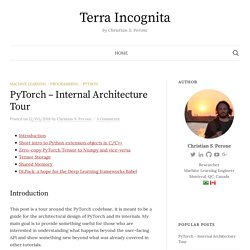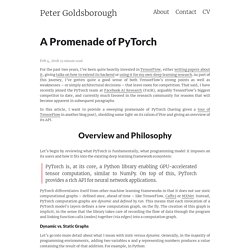

Dataloader Design for PyTorch - Tongzhou Wang, MIT. Captum · Model Interpretability for PyTorch. Handwritten Digit Recognition Using PyTorch — Intro To Neural Networks. Easy right?

— Figuring out that the above picture represents the digit four, was no deal for you. You didn’t even bother about the poor resolution of the image, how amazing. We should all take a moment to thank our brains! Wonder how natural it is for our brains to process the image, classify it and respond back. We are gifted! How difficult would it be to imitate the human brain? In this article, we will be discussing neural networks and along the way will develop a handwritten digit classifier from scratch. The only prerequisite to this article is basic knowledge about Python syntax. Step 1 — Knowing The Dataset The most crucial task as a Data Scientist is to gather the perfect dataset and to understand it thoroughly. The data set is originally available on Yann Lecun’s website. Import numpy as npimport torchimport torchvisionimport matplotlib.pyplot as pltfrom time import timefrom torchvision import datasets, transformsfrom torch import nn, optim Step 2 — Knowing The Dataset Better.
Neural Network Programming - Deep Learning with PyTorch. PyTorch internals : Inside 245-5D. This post is a long form essay version of a talk about PyTorch internals, that I gave at the PyTorch NYC meetup on May 14, 2019.

Hi everyone! Today I want to talk about the internals of PyTorch. This talk is for those of you who have used PyTorch, and thought to yourself, "It would be great if I could contribute to PyTorch," but were scared by PyTorch's behemoth of a C++ codebase. I'm not going to lie: the PyTorch codebase can be a bit overwhelming at times. The purpose of this talk is to put a map in your hands: to tell you about the basic conceptual structure of a "tensor library that supports automatic differentiation", and give you some tools and tricks for finding your way around the codebase.
The talk is in two parts: in the first part, I'm going to first introduce you to the conceptual universe of a tensor library. The second part grapples with the actual nitty gritty details involved with actually coding in PyTorch. The tensor is the central data structure in PyTorch. PyTorch under the hood. PyTorch – Internal Architecture Tour. Introduction This post is a tour around the PyTorch codebase, it is meant to be a guide for the architectural design of PyTorch and its internals.

My main goal is to provide something useful for those who are interested in understanding what happens beyond the user-facing API and show something new beyond what was already covered in other tutorials. Note: PyTorch build system uses code generation extensively so I won’t repeat here what was already described by others. If you’re interested in understanding how this works, please read the following tutorials: Short intro to Python extension objects in C/C++ As you probably know, you can extend Python using C and C++ and develop what is called as “extension”. There are two extra macros in the Python API called Py_INCREF()Py_INCREF() and Py_DECREF()Py_DECREF(), which are used to increment and decrement the reference counter of Python objects. You can read more about Python C/++ extensions here.
A Promenade of PyTorch – Peter Goldsborough. For the past two years, I’ve been quite heavily invested in TensorFlow, either writing papers about it, giving talks on how to extend its backend or using it for my own deep learning research.

As part of this journey, I’ve gotten quite a good sense of both TensorFlow’s strong points as well as weaknesses – or simply architectural decisions – that leave room for competition. That said, I have recently joined the PyTorch team at Facebook AI Research (FAIR), arguably TensorFlow’s biggest competitor to date, and currently much favored in the research community for reasons that will become apparent in subsequent paragraphs. In this article, I want to provide a sweeping promenade of PyTorch (having given a tour of TensorFlow in another blog post), shedding some light on its raîson d’être and giving an overview of its API. Overview and Philosophy PyTorch is, at its core, a Python library enabling GPU-accelerated tensor computation, similar to NumPy. Dynamic vs.